Below are photos of the painted version with Adrian helmet head by David Lane
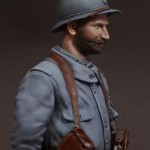
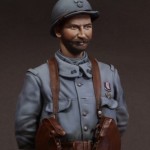
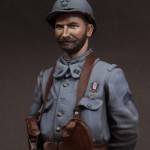
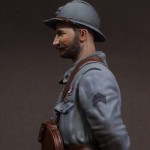
The photos below are snapshots from the 3D program used to create the master figure
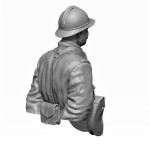
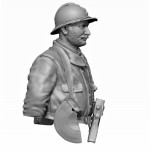
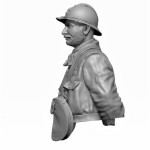
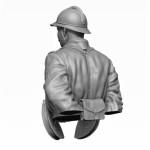
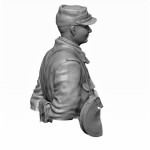
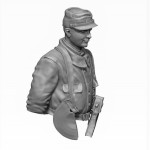
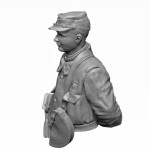
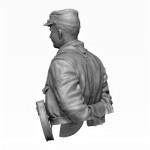
French Infantryman Chauchat MG Gunner, 62nd Regiment, 1916 – Fz. Chauchat MG Schütze, 62. Infanterieregiment, 1916
- Scale / Maßstab: 1:10
- Approx. height of bust / ca. Höhe Büste: 75mm
- Material: Resin (bust), 6mm Brass Tube (for bust mount) / Resin (Büste), 6mm Messing-Rohr (für Sockel montieren)
- Parts / Teile: 12
- Infosheet / Infoblatt: English
- Code: 32BCG
Contents Bust / Inhalt Büste:
- Upper Body / Oberkörper
- Head for Helmet / Kopf für Stahlhelm
- 2nd Alternative Head for Kepi / 2. Alternativ-Kopf für Käppi
- Adrian Helmet M1915 / Adrianhelm M1915
- Infantry Kepi M1884/1914 / Infanterie-Käppi M1884/1914
- 2 x Magazine Pouches 1st Type / 2 Stck. Magazin-Taschen Typ 1
- 2 x Magazin Belt loops (bottom half only) / 2 Stck. Magazin Gürtelschlaufen (nur untere Hälfte)
- Ruby Pistol Pouch M1916 / Ruby-Pistolentasche M1916
- Grenade Emblem (for Stand) / Grenatenemblem (für Sockel)
- 6mm Brass Tube (for bust mount) / 6mm Messing-Rohr (für Büste montieren)
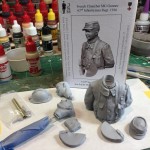
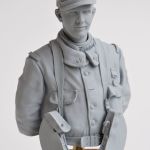
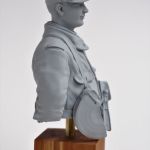
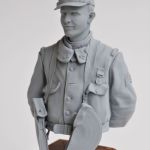
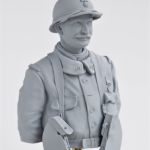
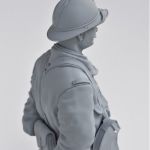
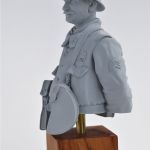
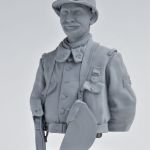
Above are the unpainted parts showing the now typical light grey resin used by JSM. On 2 of the photos, one can just make out the grenade emblem, or La grenade à 12 flammes to decorate a wooden plinth if required.
About this Bust
The bust is based on a French Chauchat MG Gunner of the 62nd Infantry Regiment photographed at Mericourt sur Somme, 12th November 1916. Here he has been awarded with the British Military Medal (probably presented by the Duke of Connaught). For what reason he received this medal and in which area of combat is unknown. The official movements of this regiment from March 1916 to January 1917 gives Verdun, but a battalion, or smaller unit may well have been attached to another Army Group, possibly during the Somme battle. Their battle history is: Marne, 1st Aisne, Champagne, Verdun, 2nd & 3rd Aisne and Meuse-Argonne and the home base was Lorient, Brittany.
He carries a reduced amount of equipment, which would normally not be sufficient for combat.
To date I have only come across the 2 original photos of this soldier. The original head wearing the Adrian helmet shows a slightly bent nose, which is more evident in the 2nd, less known photograph.
Extracts from the Infosheet with this Bust:
Other Ranks Infantry Kepi Model 1884/1914 / Képi d’Infanterie, modèle 1884/1914: The 2nd, alternative head wears the earlier type M1884 /1914 Kepi in gris bleuté. From the end of 1914, beginning of 1915, one saw more and more French troops wearing the new simplified kepi M1914 version (without piping), but there were still many of the old caps around, especially with reserve and territorial units. The chin-strap and visor were still made out of blackened leather, with Tombac (or sometimes zinc) buttons and black painted vent at each side.
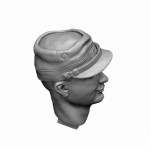
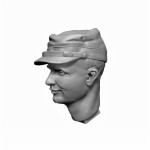
One can display this kepi in at least 2 different coloured versions. Both original items were used as references during the making of this bust. The old-type red regimental numbers on dark-blue backing were often removed from the older, pre-war red kepis and remounted to the new types, giving quite a mixture of headdress colours.
Version 1: Blue kepi with yellow piping. Red sewn-on regimental cloth patch on dark-blue backing.
Version 2: Blue-grey (gris bleuté) kepi with dark-blue piping. Regimental number as in version 1.
There are also versions of this kepi with the regimental numbers in a dark-blue on light-blue backing. The numbers have been modelled slightly more raised than would normally be the case for cloth patches – this is to enable an easier paint finish.
The alternative head for kepi has a casting web above right ear. This is to be removed before painting.
Neck Cloth: Seems to be a private item and in a somewhat lighter colour than the Service Tunic collar.
Service Tunic M1914/15: On the original photograph, under the greatcoat collar one can see parts of the service tunic M1914/15. Normally, the greatcoat was the regular combat uniform of the French Army and the tunic would only be worn in the warm months of summer. However, in cold conditions, a combination of both greatcoat and tunic were worn together giving sometimes a bulky appearance to the soldier. The collar patches for infantry regiments were normally mounted on a horizon blue backing cloth, with darker blue regimental numbers and vertical stripes (white No. and stripes were used for reserve / territorial units).
Greatcoat Model 1914/1915 – 3rd Type: This was a simplified version of the original M1877 dark blue greatcoat. The two large pockets (partly hidden behind the turned up flaps) were added towards the end of 1915 and often one sees theses made out of a different coloured material. The pockets were reinforced from within and intended for the carrying of extra ammunition. It had a large turned down collar with grey-blue metal buttons (although these tend to reflect the light somewhat, giving a shiny appearance sometimes) at the front and smaller ones on the pockets and at rear waste belt.
The distinctive turned up coat flaps were buttoned back at each sides (not seen on the bust) – here the material was reinforced at the corners. On his upper left arm are the 3 dark-blue chevron stripes, mounted on a light blue backing cloth, indicating the time served at the front. The first stripe for 1 year, with every successive stripe for ½ year service. The colour of these greatcoats varied considerably and depended on the dye used, origin, wear and tear and age of the garment.
On the original photograph the service stripes appear much lighter than they should be. This could well be due to fading, or are of a different coloured cloth altogether.
The dark-blue 62 sewn-on regimental collar patches have been modelled slightly more raised than would normally be the case in this scale – this is to enable an easier paint finish. Casting webs have been placed under the coat collar, top pocket flaps, behind / within magazine pouch attachments and belt end (bottom part, protruding out). These are to be removed before painting.
On the original photograph there appears to be what looks like a fastening strip between the coat collar ends. This is normally not a feature of these coats and I have only seen these on versions for cavalry and train (transport). This may well be a variant from a particular manufacture or an add-on feature carried out locally or by soldier. Also, one cannot see the bottom pocket flaps (not on bust model). Here they have either been pushed into the pocket openings, or are missing altogether. The top pockets seem to be quite full, with corners of contents showing up on the outer cloth (more evident on right hand pocket). Also evident is the fact that there are 2 greatcoat buttons missing from a total of 6 at the front (1 is behind belt).
On the greatcoat itself, the structure and fold of the creases follows the standard form copied from various photos of French troops in the field. It is always better when gathering reference material to use original photos of troops who have been actually wearing their uniforms over long periods of time, as most garments (as indeed all types of clothing, depending on the material used) will crease and fold in roughly the same way. Some reference books, especially for collectors of uniforms are helpful for colour-reference and information etc., but will not always portray an accurate picture of how the uniforms appeared after many days of being worn.
British Military Medal (MM): This French soldier has been awarded the Military Medal, which although generally intended for British personnel, was known to have Commonwealth and other Allied troops as recipients. The MM was the other ranks equivalent of the Military Cross (MC), which was awarded to Commissioned Officers and on the odd occasion to Warrant Officers, for bravery in battle on land. Established in March 1916, the MM was never as popular as the higher ranked Distinguished Conduct Medal (DCM), which had a money grant of twenty pounds and a sixpence a day bonus added to the soldier’s pension.
The medal ribbon is flanked by 2 dark blue thicker stripes, centred by 5 equal stripes, 3 white and 2 red. The obverse (the side of a coin or medal bearing the head or principal design) shows an image of the reigning monarch – in this case, King George V. The suspender (attachment between medal and ribbon) is decorated with scrolls. As this medal has been newly presented, it will not have signs of the normal patina seen often on these items.
Equipment
Adrian Infantry Helmet M1915 / Casque Adrian de l’infanterie française modèle 1915: The Adrian helmet, similar to the fireman, or dragoon helmets of the period, first appeared in sufficient numbers for the Champagne offensive in September 1915. By December 1915 a total of 3 million had been produced. Weighing only 765 grams and formed from relatively mild steel it did not give as much protection as its German and British counterparts. On the front is the grenade of the infantry (this would differ according to the arm of the service). Colour: the first helmets to be introduced had a shiny blue-grey finish, which by December 1915 were being covered with a khaki cloth cover. From the summer 1916 the helmets were issued in a blue-grey matt colour and were now worn without the cloth covers again (this was an official directive to avoid the cloth, which was never clean being dragged into head wounds, causing further complications).
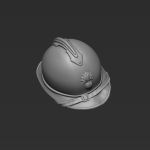
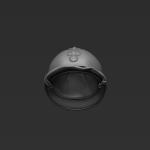
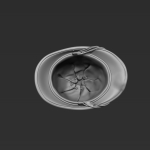
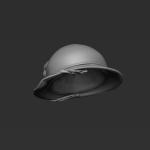
Within the square-shaped chin-strap attachments on the underside of helmet are casting webs. These are to be removed carefully before painting. The helmet has now been half filled to enable an easier casting method
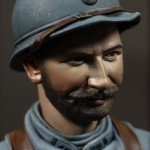
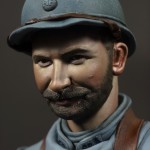
Leather Belt and Brace Equipment M1892/1914 / Bretelle de suspension Mle 1892/14: The main difference from early pre-war equipment was that since December 1914 all belts, braces and straps etc. were issued now in brown, instead of black. Also, the shoulder and rear straps are now fixed to the metal ring by means of brass rivets, rather than stitched on. The belt now has a steel two pronged buckle.
Ruby Pistol Pouch M1916 / Cartouchiere Francaise Pour Pistolet Ruby: The special brown leather holster for the Ruby pistol was similar to the standard infantry cartridge pouch, but slightly larger. It was attached with the aid of a tin-plated iron suspension ring and hook to the brace (yoke) equipment and 2 loops to the belt. A brass stud at the front held the pouch flap down. The pouch held this simple, compact, but robust Spanish made Ruby pistol, with 2 additional magazines and was the standard secondary weapon of all French GCRG gunners.
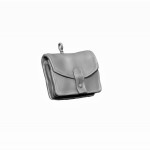
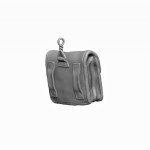
CSRG Frontal Magazine Pouches (1st type): Issued in the spring of 1916 to all CSRG gunners. These distinctive, half-moon shaped Chauchat magazine pouches were made from a thick brown leather and were at first worn with the convex sides facing inwards. Later, these pouches were swapped over on the webbing to enable a better access of the magazines by the gunner. The 2nd type version, which appeared in the summer 1917 had an additional strap fixed to the convex parts and around the gunner’s back, joining both and so keeping the pouches closer to the body during combat.
These pouches were not popular with the troops. They proved uncomfortable when firing the gun in the prone position (laying down) and the magazines were easily damaged within. Additionally, their characteristic shape, outlined against the lighter colour of French uniforms, became recognizable and an obvious target for German infantry. Two magazines would fit into each pouch, the feed-lips facing downwards and held in place with an outer flap / strap, fixed with brass stud fasteners.
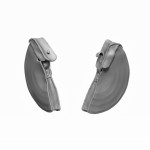
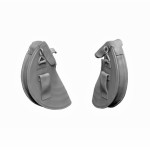
Quite often the shape of the magazines would show up on the outside of pouch, reflecting the light from the slightly raised parts. This is the case on the original photograph. It also appears that the pouches are both empty, with the right hand one left open. Casting webs have been placed at one of the pouch flap fastening studs and within the hanging down straps. These are to be removed before assembling / painting.
On the underside of body are 2 small indents for the fixing of the bottom part of magazine pouch attachment straps. These I would recommend attaching last, after the fixing of pouches.
Miscellaneous
Brass Tube: The 6mm buffed diameter brass tube supplied is to mount the bust to a suitable stand. Under the bust, an appropriate hole has been modelled in a middle position to allow the bust to be displayed. The hole will require to be drilled further into bust and is slightly larger than 6mm – this is to allow for a choice of positions / angles as required.
On my own example, I set the tube at a right angle to the bottom of bust and mounted onto a flat topped base.
The Grenade Emblem / La grenade à 12 flammes: The emblem can be used to decorate the base, or wooden plinth after the bust has been finished. It depicts the grenade of the infantry from the front of the Adrian helmet. The letters RF stand for Republique France.
On 2 of the photos, one can just make out the grenade emblem.
 An deutschsprachige Interessenten:
Sie können mich per eMail oder Telefon auch gerne auf deutsch kontaktieren. Ortsbesuch ist nach Absprache möglich.
An deutschsprachige Interessenten:
Sie können mich per eMail oder Telefon auch gerne auf deutsch kontaktieren. Ortsbesuch ist nach Absprache möglich.
